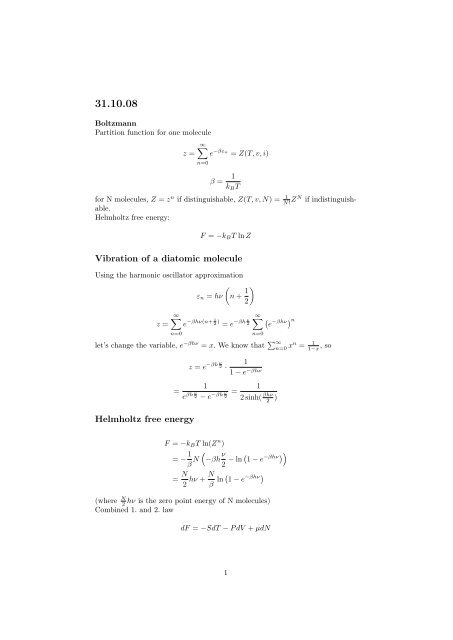Vibration of a diatomic molecule Helmholtz free energy
Vibration of a diatomic molecule Helmholtz free energy
Vibration of a diatomic molecule Helmholtz free energy
You also want an ePaper? Increase the reach of your titles
YUMPU automatically turns print PDFs into web optimized ePapers that Google loves.
31.10.08<br />
Boltzmann<br />
Partition function for one <strong>molecule</strong><br />
z =<br />
∞∑<br />
e −βεn = Z(T, v, i)<br />
n=0<br />
β = 1<br />
k B T<br />
for N <strong>molecule</strong>s, Z = z n if distinguishable, Z(T, v, N) = 1 N! ZN if indistinguishable.<br />
<strong>Helmholtz</strong> <strong>free</strong> <strong>energy</strong>:<br />
F = −k B T ln Z<br />
<strong>Vibration</strong> <strong>of</strong> a <strong>diatomic</strong> <strong>molecule</strong><br />
Using the harmonic oscillator approximation<br />
(<br />
ε n = hν n + 1 )<br />
2<br />
z =<br />
∞∑<br />
e −βhν(n+ 1 2 ) = e −βh ν 2<br />
n=0<br />
∞∑ (<br />
e<br />
−βhν ) n<br />
let’s change the variable, e −βhν = x. We know that ∑ ∞<br />
n=0 xn = 1<br />
1−x , so<br />
<strong>Helmholtz</strong> <strong>free</strong> <strong>energy</strong><br />
z = e −βh ν 2 ·<br />
n=0<br />
1<br />
1 − e −βhν<br />
1<br />
1<br />
=<br />
e βh ν 2 − e −βh = ν<br />
2<br />
2 sinh( βhν<br />
2 )<br />
F = −k B T ln(Z n )<br />
= − 1 β N (<br />
−βh ν 2 − ln ( 1 − e −βhν))<br />
= N 2 hν + N β ln ( 1 − e −βhν)<br />
(where N 2<br />
hν is the zero point <strong>energy</strong> <strong>of</strong> N <strong>molecule</strong>s)<br />
Combined 1. and 2. law<br />
dF = −SdT − P dV + µdN<br />
1
So S = − ( ∂F<br />
∂T<br />
So<br />
so<br />
)v,N = − (<br />
∂F<br />
∂β<br />
) ( )<br />
∂β<br />
βT<br />
[<br />
]<br />
βhν<br />
S = Nk<br />
e βhν − 1 − ln(1 − e−βhν<br />
F = U − T S<br />
U = F + T S<br />
[ ]<br />
1<br />
U = Nhν<br />
2 + 1<br />
e βhν − 1<br />
clearly,<br />
[ ]<br />
1<br />
〈ε〉 = hν<br />
2 + 1<br />
e βhν − 1<br />
Testing the limits<br />
As T approaches 0, β → ∞<br />
, the ZPE.<br />
As T approaches infinity, β → 0<br />
U → N hν<br />
2<br />
U = N hν<br />
2 + Nhν 1<br />
βhν + (βhν)2<br />
2<br />
+ . . .<br />
= N hν<br />
2 + N β<br />
= N hν<br />
2 + N β<br />
= N β<br />
= Nk B T<br />
= nRT<br />
1<br />
1 + βhν<br />
2<br />
+ . . .<br />
(<br />
1 + βhν )<br />
2 + . . .<br />
which is the classical result. Equipartition principle.<br />
Heat Capacity<br />
C v =<br />
( ) ∂U<br />
∂T<br />
V,N<br />
e βhν<br />
C v = Nk(βhν) 2<br />
(e βhν − 1) 2<br />
2

















